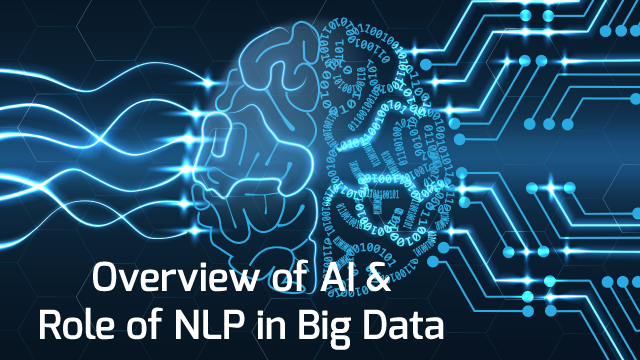Overview of Artificial Intelligence, Deep Learning and NLP in Big Data
Reading Time: 13 Minutes
Artificial Intelligence Overview
AI refers to ‘Artificial Intelligence’ which means making machines capable of performing quick tasks like human beings. AI performs automated tasks using intelligence.
The term Artificial Intelligence has two key components -
-
Automation
-
Intelligence
Goals & Applications of Artificial Intelligence
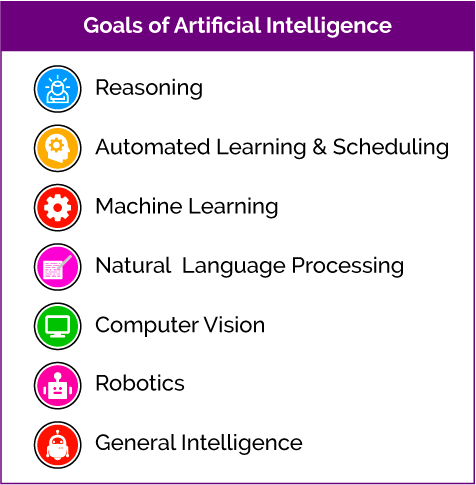
Evolution of Artificial Intelligence
-
Machine Learning
It is a set of algorithms used by intelligent systems to learn from experience.
-
Machine Intelligence
These are the advanced round of algorithms used by machines to learn from experience. E.g. - Deep Neural Networks.
Artifical Intelligence technology is currently at this stage.
-
Machine Consciousness
It is self-learning from experience without the need for external data.
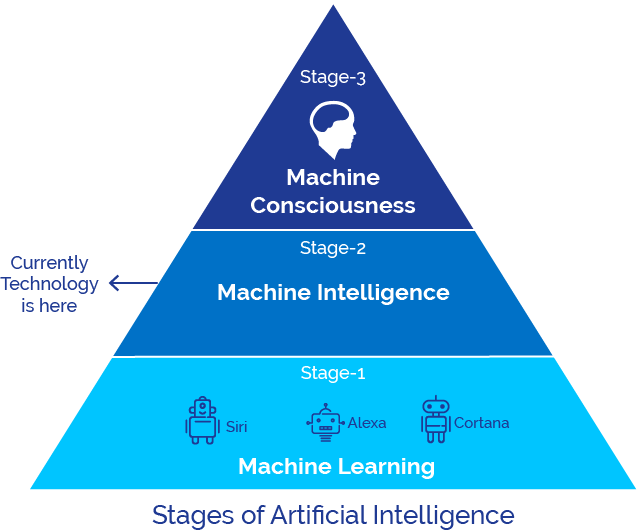
3 Types of Artificial Intelligence
-
Artificial Narrow Intelligence (ANI)
It comprises of primary/role tasks such as those performed by chatbots, personal assistants like SIRI by Apple and Alexa by Amazon.
-
Artificial General Intelligence (AGI)
Artificial General Intelligence comprises of human-level tasks such as performed by self-driving cars by Uber, Autopilot by Tesla. It involves continual learning by the machines.
-
Artificial Super Intelligence (ASI)
Artificial Super Intelligence refers to intelligence way smarter than humans.
What Makes System AI Enabled
Difference Between AI, NLP, ML, DL & Neural Networks
-
Artificial Intelligence (AI)
Building systems that can do intelligent things.
-
Natural Language Processing (NLP)
Building systems that can understand language. It is a subset of Artificial Intelligence.
-
Machine Learning (ML)
Building systems that can learn from experience. It is also a subset of Artificial Intelligence.
-
Neural Network (NN)
A biologically inspired network of Artificial Neurons.
-
Deep Learning (DL)
Building systems that use Deep Neural Network on a large set of data. It is a subset of Machine Learning.
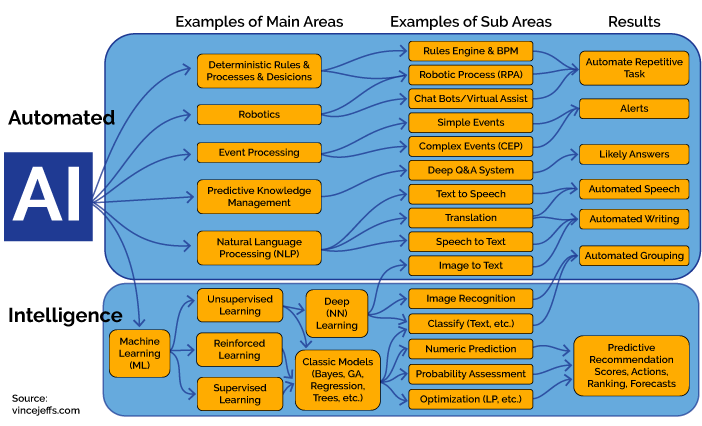
What is Natural Language Processing(NLP)?
Natural Language Processing (NLP) is “ability of machines to understand and interpret human language the way it is written or spoken.”
The objective of NLP is to make computer/machines as intelligent as human beings in understanding language.

The ultimate goal of NLP is to the fill the gap how the people communicate (natural language) and what the computer understands (machine language).
There are three different levels of linguistic analysis done before performing NLP-
- Syntax - What part of given text is grammatically right.
- Semantics - What is the meaning of given text?
- Pragmatics - What is the purpose of the text?
NLP deal with different aspects of language such as
- Phonology - It is systematic organization of sounds in language.
- Morphology - It is a study of words formation and their relationship with each other.
Approaches of NLP for understanding semantic analysis
-
Distributional - It employs large-scale statistical tactics of Machine Learning and Deep Learning.
-
Frame-Based - The sentences which are syntactically different but semantically same are represented inside data structure (frame) for the stereotyped situation.
-
Theoretical - This approach builds on the idea that sentences refer to the real world (the sky is blue) and parts of the sentence can be combined to represent whole meaning.
-
Interactive Learning - It involves pragmatic approach and user is responsible for teaching the computer to learn the language step by step in an interactive learning environment.
The real success of NLP lies in the fact that humans deceive into believing that they are talking to humans instead of computers.
Importance of Natural Language Processing(NLP)
With NLP, it is possible to perform certain tasks like Automated Speech and Automated Text Writing in less time.
Due to the presence of significant data (text) around, why not we use the computers untiring willingness and ability to run several algorithms to perform tasks in no time.
These tasks include other NLP applications like Automatic Summarization (to generate summary of given text) and Machine Translation (translation of one language into another)
Process of Natural Language Processing
In case the text is composed of speech, speech-to-text conversion is performed.
The mechanism of Natural Language Processing involves two processes -
-
Natural Language Understanding
-
Natural Language Generation
Natural Language Understanding
NLU or Natural Language Understanding tries to understand the meaning of given text. The nature and structure of each word inside text must be known for NLU. For understanding structure, NLU attempting to resolve following ambiguity present in natural language -
-
Lexical Ambiguity - Words have multiple meanings
-
Syntactic Ambiguity - Sentence is having multiple parse trees.
-
Semantic Ambiguity - Sentence having multiple meanings
-
Anaphoric Ambiguity - Phrase or word which is previously mentioned but has a different meaning.
Next, the sense of each word is understood by using lexicons (vocabulary) and set of grammatical rules.
However, certain different words are having similar meaning (synonyms) and words having more than one meaning (polysemy).
Natural Language Generation
It is the process of automatically producing text from structured data in a readable format with meaningful phrases and sentences. The problem of natural language generation is hard to deal. It is subset of NLP
Natural language generation divided into three proposed stages -
- Text Planning - Ordering of the primary content in structured data is done.
- Sentence Planning - The sentences are combined with structured data to represent the flow of information.
- Realization - Grammatically correct sentences are produced finally to represent text.
Difference Between NLP and Text Mining
Natural language processing is responsible for understanding meaning and structure of given text.
Text Mining or Text Analytics is a process of extracting hidden information inside text data through pattern recognition.

Natural language processing is used to understand the meaning (semantics) of given text data, while text mining is used to understand structure (syntax) of given text data.
As an example - I found my wallet near the bank. The task of NLP is to figure out in the end that ‘bank’ refers to financial institute or ‘river bank.'
What is Big Data?
According to the Author Dr. Kirk Borne, Principal Data Scientist, Big Data Definition is described as big data is everything, quantified, and tracked.
Big Data For Natural Language Processing
Today around 80 % of total data is available in the raw form. Big Data comes from information stored in big organizations as well as enterprises. Examples include information about employees, company purchase, sale records, business transactions, the previous record of organizations, social media, etc.
Though human uses language, which is ambiguous and unstructured to be interpreted by computers, yet with the help of NLP, this large unstructured data can be harnessed for evolving patterns inside data to know better the information contained in data.
NLP can solve significant problems of the business world by using Big Data. Be it any business of retail, healthcare, business, financial institutions.
What is a Chatbot?
Chatbots or Automated Intelligent Agents
-
These are the computer program you can talk to through messaging apps, chat windows or through voice calling apps.
-
These are intelligent digital assistants used to resolve customer queries in a cost-effective, quick, and consistent manner.
Why Are Chatbots Essential For Business
Chatbots are critical to understanding changes in digital customer care services provided and in many routine queries that are most frequently enquired.
Chatbots are useful in a certain scenario when the client service requests are specified in the area and highly predictable, managing a high volume of similar requests, automated responses.
How Does A Chatbot Work?
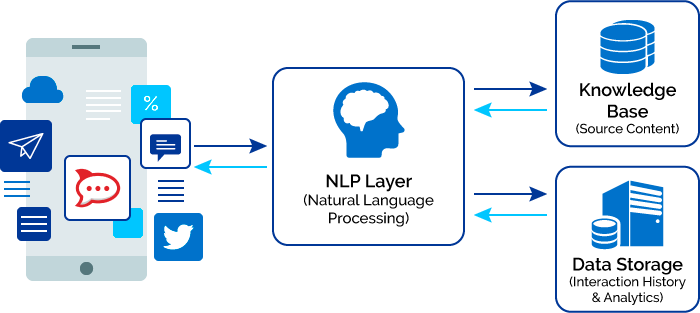
Image Source - blog.wizeline.com
- Knowledge Base - It contains the database of information that is used to equip chatbots with the information needed to respond to queries of customers request.
- Data Store - It contains interaction history of chatbot with users.
- NLP Layer - It translates users queries (free form) into information that can be used for appropriate responses.
- Application Layer - It is the application interface that is used to interact with the user.
Chatbots learn each time they make interaction with the user trying to match the user queries with the information in the knowledge base using Machine Learning.
You May also Love to Read Ingestion & Processing of Data For Big Data & IoT Solutions
Deep Learning For NLP
-
It uses a rule-based approach that represents Words as ‘One-Hot’ encoded vectors.
-
The traditional method focuses on syntactic representation instead of semantic representation.
-
Bag of words - classification model is unable to distinguish certain contexts.
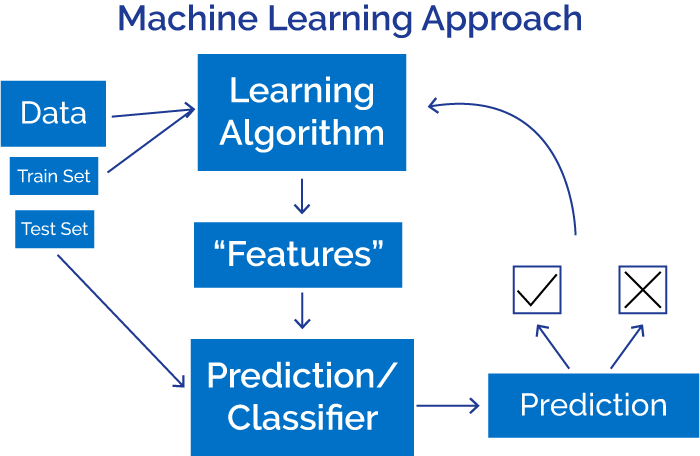
3 Capability Levels of Deep Learning Intelligence
-
Expressibility - This quality describes how well a machine can approximate universal functions.
-
Trainability - How well and quickly a Deep Learning system can learn its problem.
-
Generalizability - How well the machine can perform predictions on data that it has not been trained.
There are of course other capabilities that also need to be considered in Deep Learning such as Interpretability, modularity, transferability, latency, adversarial stability, and security. But these are the main ones.
Applications of Deep Learning in NLP
|
Deep Learning Algorithms |
NLP Usage |
|---|---|
Neural Network - NN (feed) |
|
Recurrent Neural Networks -(RNN) |
|
Recursive Neural Networks |
|
Convolutional Neural Network -(CNN) |
|
Difference Between Classical NLP & Deep Learning NLP
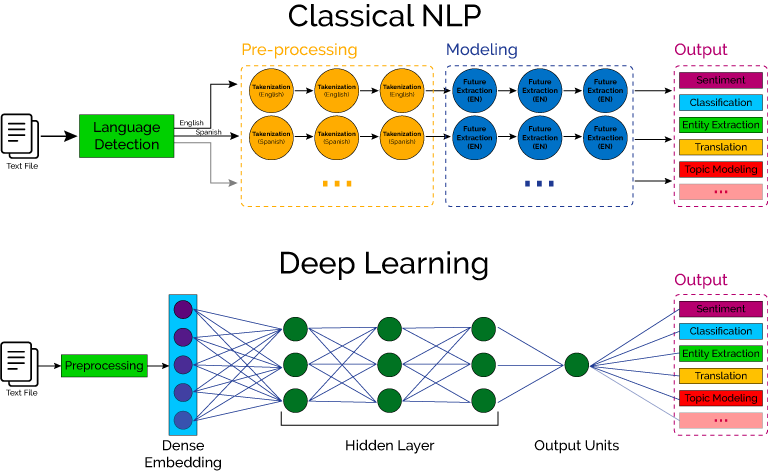
Image Source - blog.aylien.com
NLP For Log Analysis and Log Mining
What is Log?
A collection of messages from different network devices and hardware in time sequence represents a log. Logs may be directed to files present on hard disks or can be sent over the network as a stream of messages to log collector.
Logs provide the process to maintain and track the hardware performance, parameters tuning, emergency and recovery of systems and optimization of applications and infrastructure.
You May also Love to Read Understanding Log Analytics, Log Mining & Anomaly Detection
What is Log Analysis?
Log analysis is the process of extracting information from logs considering the different syntax and semantics of messages in the log files and interpreting the context with application to have a comparative analysis of log files coming from various sources for Anomaly Detection and finding correlations.
What is Log Mining?
Log Mining or Log Knowledge Discovery is the process of extracting patterns and correlations in logs to reveal knowledge and predict Anomaly Detection if any inside log messages.
Role of NLP in Log Analysis & Log Mining
Natural Language processing techniques are widely used in Log Analysis and Log Mining.
The different techniques such as tokenization, stemming, lemmatization, parsing, etc. are used to convert log messages into structured form.
Once logs are available in the well-documented form, log analysis, and log mining is performed to extract useful information and knowledge is discovered from information.
The example in case of error log caused due to server failure.
Natural Language Processing Techniques
Different methods used for performing log analysis are described below
-
Pattern Recognition
It is one such technique which involves comparing log messages with messages stored in pattern book to filter out messages.
-
Text Normalization
Normalization of log messages is done to convert different messages into the same format. This is done when different log messages have different terminology, but the same interpretation is coming from various sources like applications or operating systems.
-
Automated Text Classification & Tagging
Classification & Tagging of different log messages involves ordering of messages and tagging them with the various keywords for later analysis.
-
Artificial Ignorance
It is a kind of technique using Machine Learning Algorithms to discard uninteresting log messages. It is also used to detect an Anomaly in the ordinary working of systems.
You May also Love to Read Log Analytics With Deep Learning & Machine Learning
Diving into Natural Language Processing
Natural language processing is a complex field and is the intersection of Artificial Intelligence, computational linguistics, and computer science.
Getting started with Natural Language Processing
The user needs to import a file containing text written. Then the user should perform the following steps for natural language processing.
|
Technique |
Example |
Output |
|---|---|---|
|
Sentence Segmentation |
Mark met the president. He said:”Hi! What’s up -Alex?” |
|
|
Tokenization |
My phone tries to ‘charging’ from ‘discharging’ state. |
|
|
Stemming/Lemmatization |
Drinking, Drank, Drunk |
|
|
Part-of-Speech tagging |
If you build it he will come. |
|
|
Parsing |
Mark and Joe went into a bar. |
|
|
Named Entity Recognition |
Let’s meet Alice at 6 am in India. |
|
|
Coreference resolution |
Mark went into the mall. He thought it was a shopping mall. |
|
-
Sentence segmentation - It identifies sentence boundaries in the given text, i.e., where one sentence ends and where another sentence begins. Sentences are often marked ended with punctuation mark ‘.’
-
Tokenization - It identifies different words, numbers, and other punctuation symbols.
-
Stemming - It strips the ending of words like ‘eating’ is reduced to ‘eat.’
-
Part of speech (POS) tagging - It assigns each word in a sentence its own part-of-speech tag such as designating word as noun or adverb.
-
Parsing - It involves dividing given text into different categories. To answer a question like this part of sentence modify another part of the sentence.
-
Named Entity Recognition - It identifies entities such as persons, location and time within the documents.
-
Co-Reference resolution - It is about defining the relationship of given the word in a sentence with a previous and the next sentence.
Key Application Areas of Natural Language Processing
Apart from use in Big Data, Log Mining, and Log Analysis, it has other significant application areas.
Although the term ‘NLP’ is not as popular as ‘big data’ ‘machine learning’ but we are using NLP every day.
-
Automatic Text Summarizer
Given the input text, the task is to write a summary of text discarding irrelevant points.
-
Sentiment-based Text Analysis
It is done on the given text to predict the subject of the text, eg, whether the text conveys judgment, opinion or reviews, etc
-
Text Classification
It is performed to categorize different journals, news stories according to their domain. Multi-document classification is also possible. A famous example of text classification is spam detection in emails.
Based on the style of the writing in the journal, its attribute can be used to detect its author name.
-
Information Extraction
Information extraction is something which proposes email program add events to the calendar automatically.

How Can Don Help You?
Unlock the Real Value of your Data with our Data Science Services and Solutions. Take Advantage of Business Analytics Solutions and Data Science Consulting to accelerate your Enterprise Growth.
-
Text Analytics Solutions
Text Analytics or Text Mining refers to the automatic extraction of high-value information from text. The extraction involves structuring the input text, discovering patterns in the structured data and interpreting the results. Text Mining process involves Machine Learning, Statistics, Data Mining, and Computational Linguistics. Sentiment Analysis Using Machine Learning, NLP, and Deep Learning
At Don, we process and analyze textual content and provide valuable insights by transforming the raw data into structured, usable information. Don's Text Analytics Solutions offers Part-of-Speech (PoS) tagging, Clustering, Classification, Information Extraction, Sentiment Analysis and more.
Sentiment Analysis helps to apprehend people's reaction to situations. Sentiment Analysis is used to predict person's emotions like angry, happy, sad, disgust etc.
Don offers Sentiment Analysis and Intent Analytics using Machine Learning, Natural Language Processing, Deep Learning, Supervised Learning Algorithms, Keras with Tensorflow. Enhance the customer experience through Sentiment Analysis in Business.
-
Enterprise Chatbot Solutions
Build, Deploy and Manage Intelligent Chatbots to interact naturally with a user on Website, Apps, Slack, Facebook Messenger and more. Don Chatbot Solutions uses Cognitive Intelligence that enables bot to see, hear, and interpret in more human ways.

